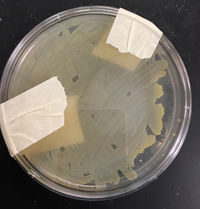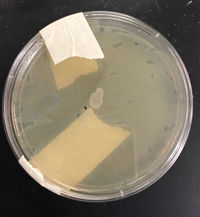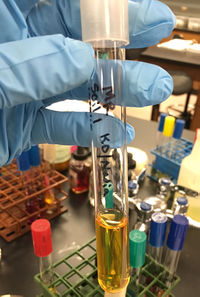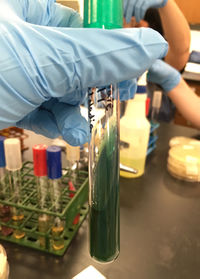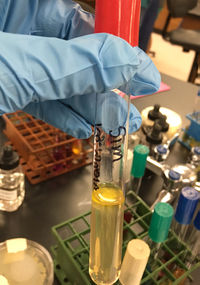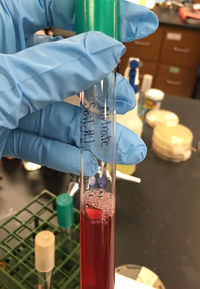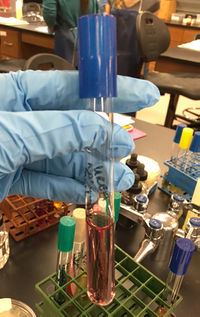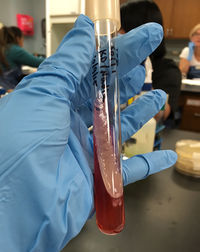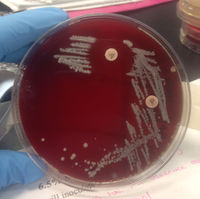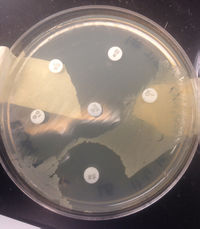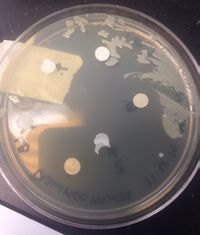Arthrobacter oxydans
Classification
Domain: Bacteria
Phylum: Actinobacteria
Class: Actinobacteria
Order: Actinomycetales
Family: Micrococcaceae
Genus: Arthrobacter
Species: oxydans
Species
|
NCBI: Taxonomy |
Arthrobacter oxydans
Habitat Information
The location where I grabbed my soil sample was in Round Rock, Texas, on the edge of a residential area and a parking lot. It was September 02, 2015 around noon and the temperature was 90ºF with humidity of 45% and air pressure of 30 inches. There was no rainfall on that day or the past seven. I grabbed the surface soil which was very rocky and then an hour later I was able to do soil dilutions. The precise GPS location of my soil sample location was 30º29'56.9" N and 97º36'05.1" W.
Description and Significance
When cultured on an LB agar, Arthrobacter oxydans is a milky white, opaque, round, convex and small, almost punctiform shape.
When it comes to Arthrobacter, it's a special cellular shape. Depending on what point you stain the bacteria, you can get either rods, or cocci. In the younger phase, when plated on to fresh media, Arthrobacter tends to be a rod shaped and upon aging tends to morph into it's cocci stage, in which was the stage we were able to observe it under a microscope. It was also gram-positive (but can appear gram-negative in younger stages) and our endospore stain showed that it was a non spore producing bacterium without a capsule.
Arthrobacter is also non-motile and completely susceptible to E. coli and S. aureus, with our plates being overgrown with each bacteria.
Genome Structure
The genome of Arthrobacter sp. Rue61a consists of a single circular chromosome of 4,736,495 bp. The genome of strain Rue61a contains numerous genes associated with osmoprotection, and a high number of genes coding for transporters. It encodes a broad spectrum of enzymes for the uptake and utilization of various sugars and organic nitrogen compounds. Rue61a reflects the saprophytic lifestyle and nutritional versatility of the organism and a strong adaptive potential to environmental stress.
Our 16S ribosomal sequence we obtained from PCR and sequencing is:
FORWARD: ATGCAGCGACGCCGCGTGAGGGATGACGGCCTTC
GGGTTGTAAACCTCTTTCAGTAGGGAAGAAGCGAAAGTGACGGTACCTGCA
GAAGAAGCGCCGGCTAACTACGTGCCAGCAGCCGCGGTAATACGTAGGGCG
CAAGCGTTATCCGGAATTATTGGGCGTAAAGAGCTCGTAGGCGGTTTGTCG
CGTCTGCCGTGAAAGTCCGGGGCTCAACTCCGGATCTGCGGTGGGTACGG
GCAGACTAGAGTGATGTAGGGGAGACTGGAATTCCTGGTGTAGCGGTGAA
ATGCGCAGATATCAGGAGGAACACCGATGGCGAAGGCAGGTCTCTGGGCA
TTAACTGACGCTGAGGAGCGAAAGCATGGGGAGCGAACAGGATTAGATAC
CCTGGTAGTCCATGCCGTAAACGTTGGGCACTAGGTGTGGGGGACATTCC
ACGTTTTCCGCGCCGTAGCTAACGCATTAAGTGCCCCGCCTGGGGAGTAC
GGCCGCAAGGCTAAAACTCAAAGGAATTGACGGGGGCCCGCACAAGCGG
CGGAGCATGCGGATTAATTCGATGCAACGCGAAGAACCTTACCAAGGCTT
GACATGAACCGGAAATACCTGGAGACAGGTGCCCCGCTTGCGGTCGGTT
TACAGGTGGTGCATGGTTGTCGTCAGCTCGTGCCGTGAG
REVERSE: CCGACCGCAAGCGGGGCACCTGTCTCCAGGTATTTCCGGTTCATG TCAAGCCTTGGTAAGGTTCTTCGCGTTGCATCGAATTAATCCGCATGCTCCGCCGCTTGTGCGGGCCCCCGTCAATTCCT TTGAGTTTTAGCCTTGCGGCCGTACTCCCCAGGCGGGGCACTTAATGCGTTAGCTACGGCGCGGAAAACGTGGAATGTCC CCCACACCTAGTGCCCAACGTTTACGGCATGGACTACCAGGGTATCTAATCCTGTTCGCTCCCCATGCTTTCGCTCCTCA GCGTCAGTTAATGCCCAGAGACCTGCCTTCGCCATCGGTGTTCCTCCTGATATCTGCGCATTTCACCGCTACACCAGGAA TTCCAGTCTCCCCTACATCACTCTAGTCTGCCCGTACCCACCGCAGATCCGGAGTTGAGCCCCGGACTTTCACGGCAGAC GCGACAAACCGCCTACGAGCTCTTTACGCCCAATAATTCCGGATAACGCTTGCGCCCTACGTATTACCGCGGCTGCTGGC ACGTAGTTAGCCGGCGCTTCTTCTGCAGGTACCGTCACTTTCGCTTCTTCCCTACTGAAAGAGGTTTACAACCCGAAGGC CGTCATCCCTCACGCGGCGTCGCTGCATCAGGCTTGCGCCCATTGTGCAATATTCCCCACTGCTGCCTCCCGTAGGAGTA CTG
Cell Structure, Metabolism and Life Cycle
The genus Arthrobacterincludes catalase-positive coryneform bacteria with an oxidative metabolism, the cell wall of which contains L-lysine as the diamino acid and cellular fatty acids of the branched type.
Physiology and Pathogenesis
BIOCHEMICAL TEST RESULTS
- Phenol Red Broth Tests: Glucose: negative; Lactose: negative; Sucrose: positive
- Starch Hydrolysis Test: positive
- Casein Hydrolysis Test: positive
- Gelatin Hydrolysis Test: negative
- DNA Hydrolysis Test: negative
- Lipid Hydrolysis Test: positive
- Methyl Red Test: negative
- Voges Proskauer Test: negative
- Citrate Test: negative
- SIM Tests: negative for all three
- Nitrate Reduction: negative
- Urea Hydrolysis: negative
- Triple Sugar Iron Agar: negative
- Oxidase Test: negative
- Eosin Methylene Blue Agar (EMB) Test: negative
- Hektoen Enteric Agar (HE) Test: negative
- MacConkey Agar Test: negative
- Decarboxylation Tests: Arginine: negative; Lysine: negative; Orinithine: negative
- Phenylalanine Deaminase Test: negative
- Catalase Test: positive
- Blood Agar Test: negative
- Mannitol Salt Agar (MSA) Test: negative
- Phenylethyl Alcohol Agar (PEA) Test: negative
- Bacitracin/Optochin Susceptibility Test: Bacitracin: susceptible; Optochin: resistant
- Antimicrobial Sensitivity (Kirby-Bauer Method) Test: Vancomyocin: susceptible; Sufisoxazole: susceptible; Linezolid: susceptible Bacitracin: susceptible; Oxacillin: resistant; Cefoxifin: susceptible
- Disinfectant Sensitivity Test: Cinnamon: susceptible; Tea Tree Oil: susceptible; 70% Isopropyl Alcohol: susceptible 10% Lysol: susceptible; 10% Bleach: resistant; Orange Oil: susceptible
The pathological significance has yet to be assessed. Several studies have shown that this bacteria has been isolated from superficial body sites and blood after surgery but their role in disease is still unknown. They were not considered to be environmental contaminants since, except in blood cultures, numerous colonies were present at primary isolation. This bacteria is susceptible to many antibiotics.
References
Funke G., von Graevenitz A., Clarridge III J. E., Bernard K. A. (1997) Clinical microbiology of coryneform bacteria. Clin. Microbiol. Rev. 10:125–159.
Morphology and physiology of coryneform bacteria. (1974). Antonie Van Leeuwenhoek: Journal of Microbiology, 40(3), 361-376. Retrieved November 30, 2015
Niewerth et al.: Complete genome sequence and metabolic potential of the quinaldine-degrading bacterium Arthrobacter sp. Rue61a. BMC Genomics 2012 13:534.
Author
Page authored by Nadia Didehbani and Kendra Dubec, students of Prof. Kristine Hollingsworth at Austin Community College.

